2005 RENAULT MEGANE weight
[x] Cancel search: weightPage 6 of 250

Downloaded from www.Manualslib.com manuals search engine
NU761_2_G1-FRA.qxd 10/11/05 15:52 Page 0.04
0.04
TYRE PRESSURES (in bar or kg per cm²when cold)
Versions
Tyre sizes
Wheel sizes
Non-motorway use
Front
Rear
Motorway use (1)
Front
Rear 1.4 16V 1.6 16V 2.0 16V - 2.0 T
195/65 R15 T
205/55 R16 H 205/55 R16 V
205/50 R17 V
6.5 J 15
6.5 J 16
6.5 J 17
2.2
2.0
2.2
2.0
2.2 195/65 R15 H
205/55 R16 H
205/55 R16 V
6.5 J 15
6.5 J 16
2.2
2.0
2.3
2.0
2.3 205/50 R17 V
2.2
2.0
2.4 2.4
2.0
6.5 J 17
195/65 R15 H
205/55 R16 H
205/55 R16 V
2.2
2.0
6.5 J 15
6.5 J 16
2.4
2.0 2.3
2.0
2.4 6.5 J 17
2.5
205/50 R17 V
Emergency spare wheel 2.5
2.0
Tyre safety and use of snow chains
Refer to the paragraph on “Tyres” in Section 5 for information on maintenance and, depending on t\
he version, the
conditions under which chains may be fitted to the vehicle.
(1) Special note concerning vehicles used under full load (Maximum Permissi\
ble All-Up Weight) and towing a trailer
The maximum speed must be limited to 60 mph (100 km/h)and the tyre pressure increased by 0.2 bar.
Refer to the information on Weights in Section 6.
NU761_2_G1-ENG.qxp 1/6/2006 12:23 PM Page 0.04 (Black plate)
Page 7 of 250
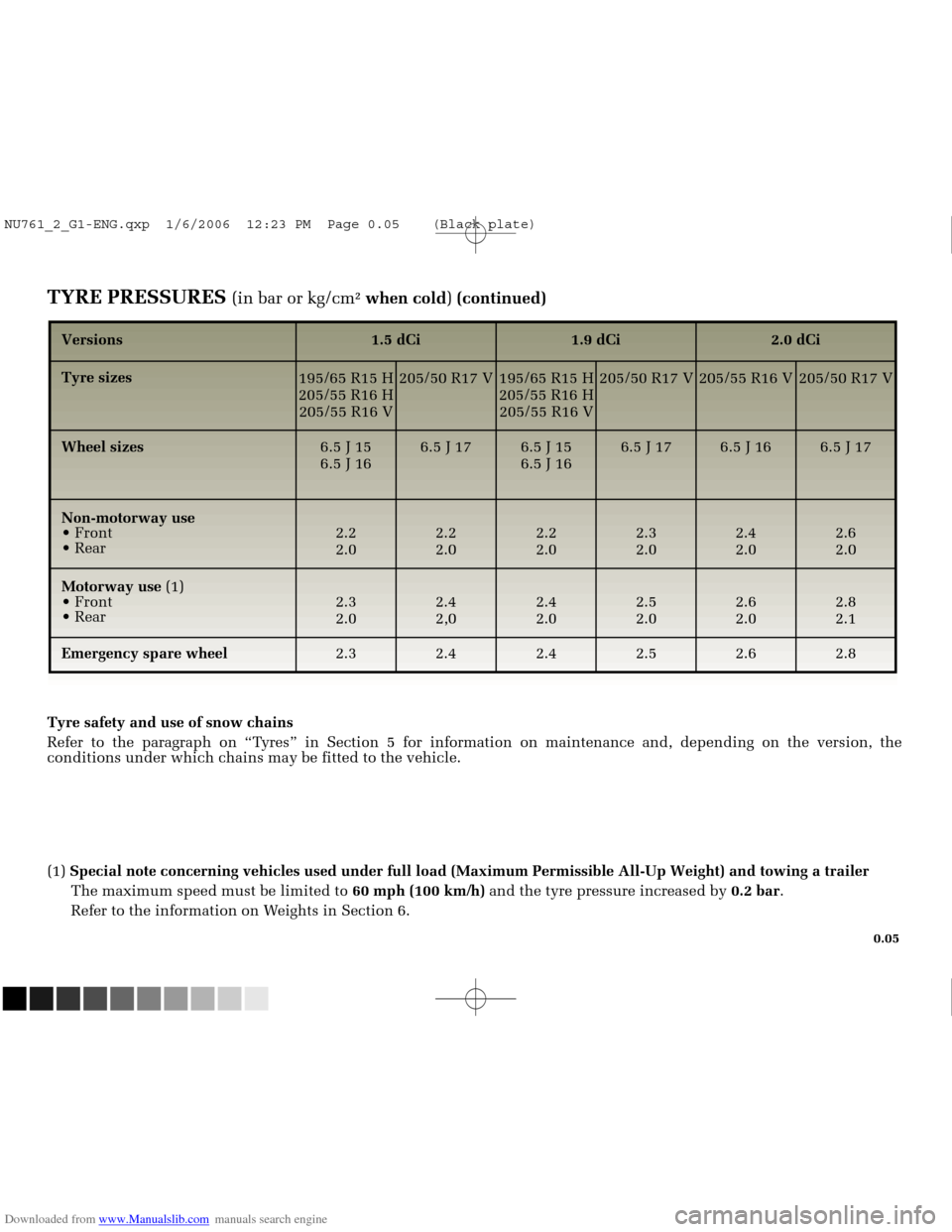
Downloaded from www.Manualslib.com manuals search engine
NU761_2_G1-FRA.qxd 10/11/05 15:52 Page 0.05
0.05
TYRE PRESSURES(in bar or kg/cm²when cold)(continued)
Versions
Tyre sizes
Non-motorway use
Front
Rear Wheel sizes
Motorway use (1)
Front
Rear
Emergency spare wheel 1.5 dCi 1.9 dCi 2.0 dCi
6.5 J 172.6
2.0
205/50 R17 V
2.8
2.1
2.6
205/55 R16 V
2.8
2.6
2.0
6.5 J 16
2.3
2.0
2.5 2.4
2.0
2.5
2.0
205/50 R17 V
195/65 R15 H
205/55 R16 H
205/55 R16 V
2.2
2.0 6.5 J 17
2.4
2.0
6.5 J 15
6.5 J 16
2.4
2.3 2.4
2,0
2.3
2.0 2.2
2.0
2.4 2.2
2.0
6.5 J 15
6.5 J 16
195/65 R15 H
205/55 R16 H
205/55 R16 V
6.5 J 17
205/50 R17 V
Tyre safety and use of snow chains
Refer to the paragraph on “Tyres” in Section 5 for information on maintenance and, depending on t\
he version, the
conditions under which chains may be fitted to the vehicle.
(1) Special note concerning vehicles used under full load (Maximum Permissi\
ble All-Up Weight) and towing a trailer
The maximum speed must be limited to 60 mph (100 km/h)and the tyre pressure increased by 0.2 bar.
Refer to the information on Weights in Section 6.
NU761_2_G1-ENG.qxp 1/6/2006 12:23 PM Page 0.05 (Black plate)
Page 8 of 250
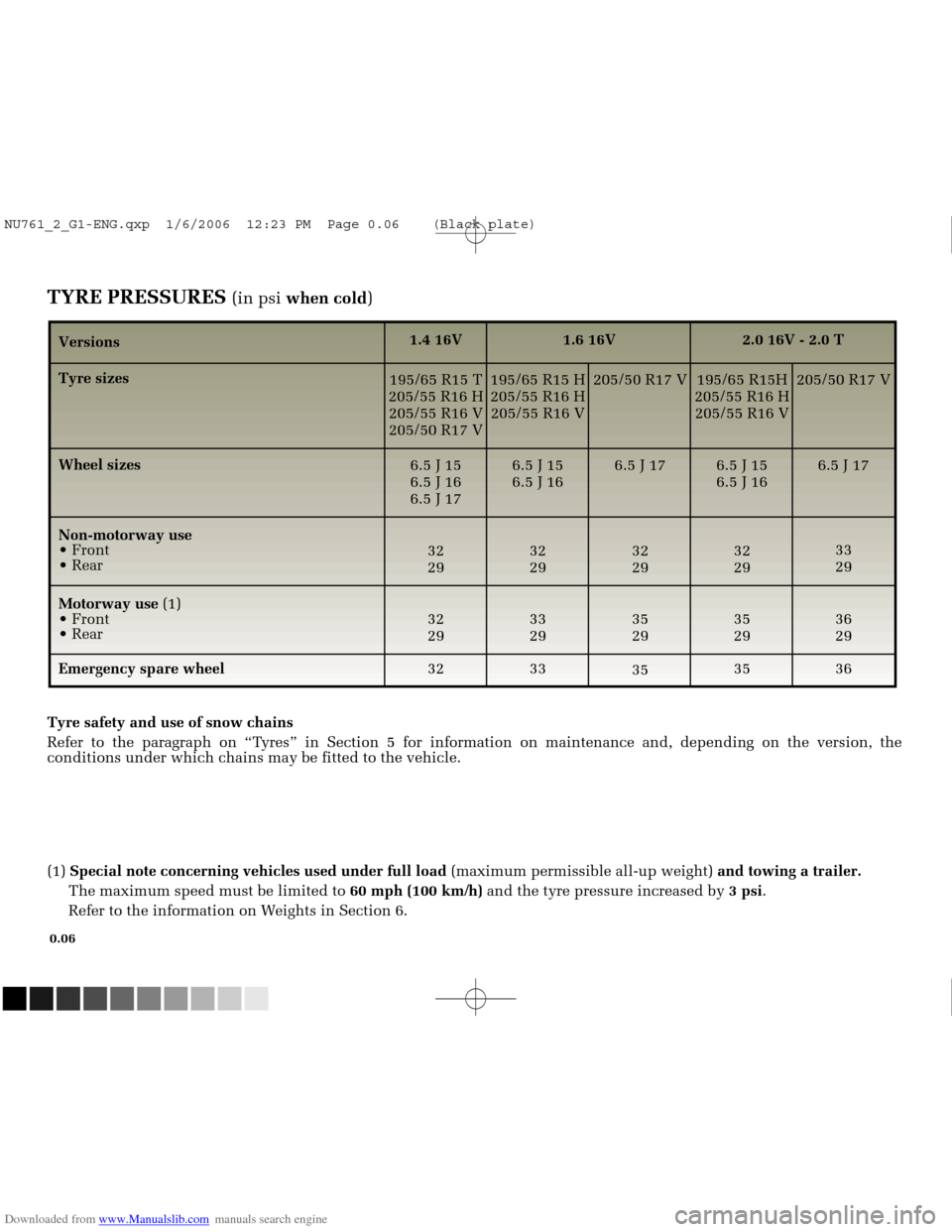
Downloaded from www.Manualslib.com manuals search engine
NU761_2_G1-FRA.qxd 10/11/05 15:52 Page 0.06
0.06
TYRE PRESSURES (in psi when cold )
Versions
Tyre sizes
Wheel sizes
Non-motorway use
Front
Rear
Motorway use (1)
Front
Rear 1.4 16V 1.6 16V 2.0 16V - 2.0 T
195/65 R15 T
205/55 R16 H 205/55 R16 V
205/50 R17 V
6.5 J 15
6.5 J 16
6.5 J 17
32
29
32
29
32 195/65 R15 H
205/55 R16 H
205/55 R16 V
6.5 J 15
6.5 J 16
32
29
33
29
33 205/50 R17 V
32
29
35 35
29
6.5 J 17
195/65 R15H
205/55 R16 H 205/55 R16 V
32
29
6.5 J 15
6.5 J 16
35
29 33
29
35 6.5 J 17
36
205/50 R17 V
Emergency spare wheel 36
29
Tyre safety and use of snow chains
Refer to the paragraph on “Tyres” in Section 5 for information on maintenance and, depending on t\
he version, the
conditions under which chains may be fitted to the vehicle.
(1) Special note concerning vehicles used under full load (maximum permissible all-up weight) and towing a trailer.
The maximum speed must be limited to 60 mph (100 km/h)and the tyre pressure increased by 3 psi.
Refer to the information on Weights in Section 6.
NU761_2_G1-ENG.qxp 1/6/2006 12:23 PM Page 0.06 (Black plate)
Page 9 of 250
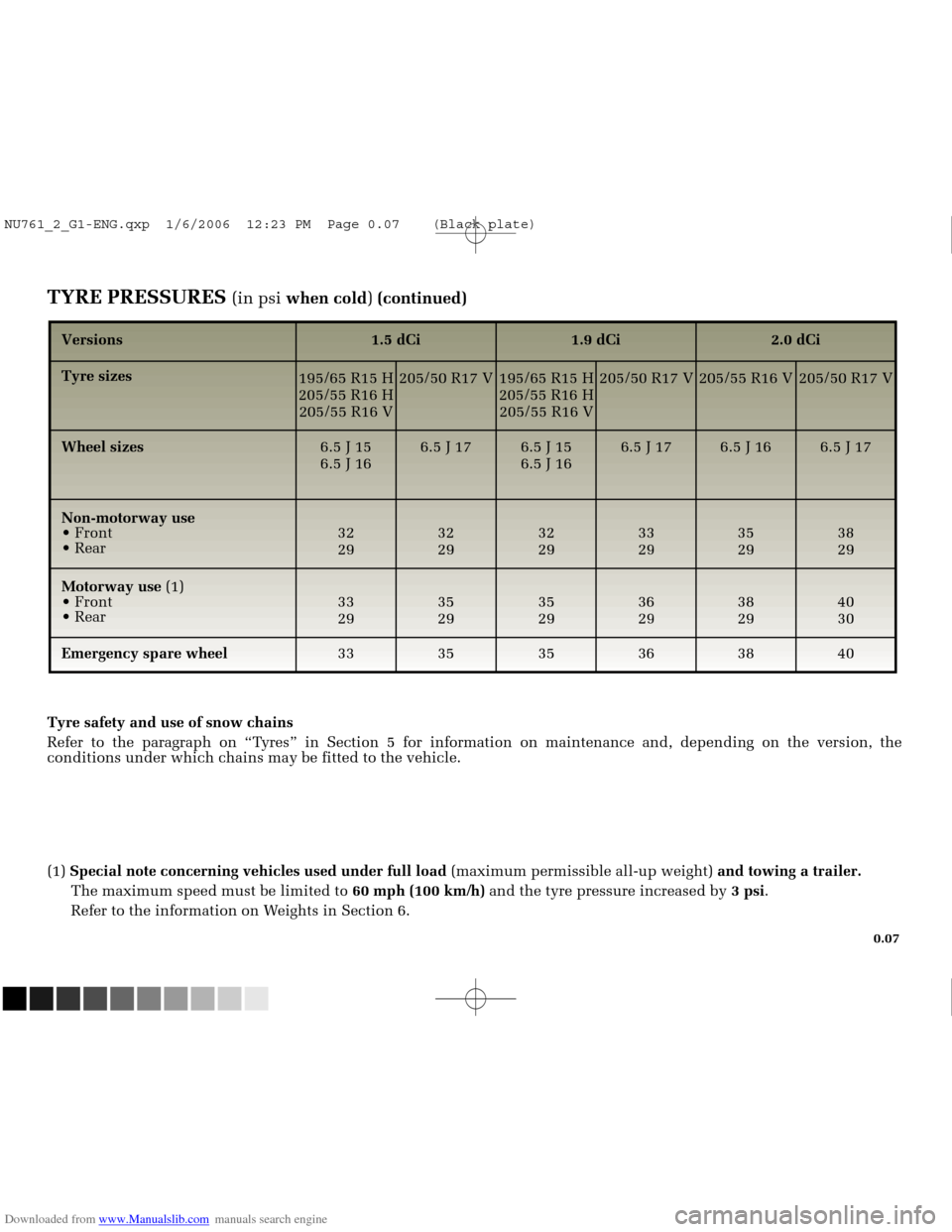
Downloaded from www.Manualslib.com manuals search engine
NU761_2_G1-FRA.qxd 10/11/05 15:52 Page 0.07
0.07
TYRE PRESSURES (in psi when cold )(continued)
(1) Special note concerning vehicles used under full load (maximum permissible all-up weight) and towing a trailer.
The maximum speed must be limited to 60 mph (100 km/h)and the tyre pressure increased by 3 psi.
Refer to the information on Weights in Section 6.
Tyre safety and use of snow chains
Refer to the paragraph on “Tyres” in Section 5 for information on maintenance and, depending on t\
he version, the
conditions under which chains may be fitted to the vehicle.
Versions
Tyre sizes
Non-motorway use
Front
Rear Wheel sizes
Motorway use
(1)
Front
Rear
Emergency spare wheel 1.5 dCi 1.9 dCi 2.0 dCi
6.5 J 1738
29
205/50 R17 V
40
30
38
205/55 R16 V
40
38
29
6.5 J 16
33
29
36 35
29
36
29
205/50 R17 V
195/65 R15 H
205/55 R16 H
205/55 R16 V
32
29 6.5 J 17
35
29
6.5 J 15
6.5 J 16
35
33 35
29
33
29 32
29
35 32
29
6.5 J 15
6.5 J 16
195/65 R15 H
205/55 R16 H
205/55 R16 V
6.5 J 17
205/50 R17 V
NU761_2_G1-ENG.qxp 1/6/2006 12:23 PM Page 0.07 (Black plate)
Page 42 of 250
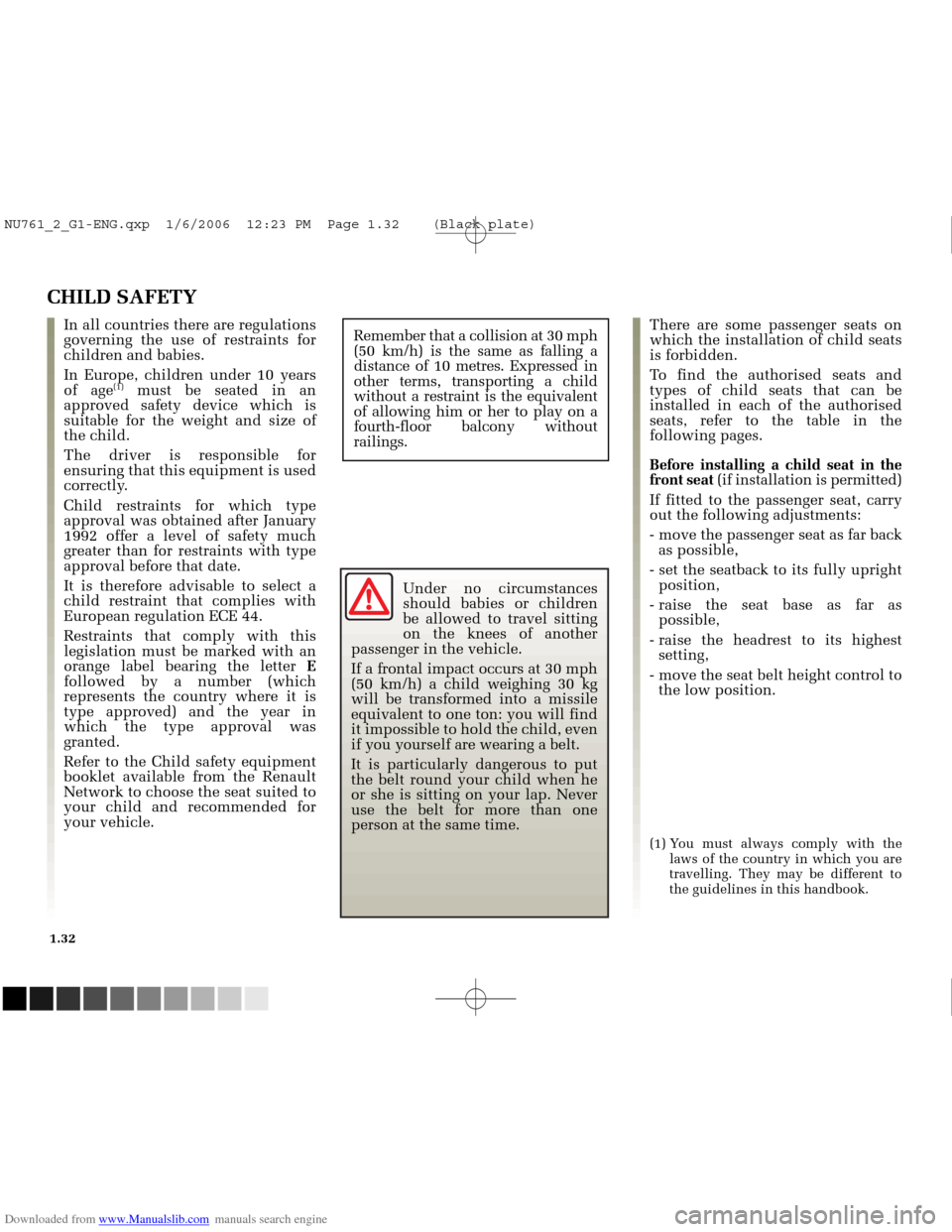
Downloaded from www.Manualslib.com manuals search engine
NU761_2_G1-FRA.qxd 10/11/05 15:53 Page 1.32
1.32
Under no circumstances
should babies or children
be allowed to travel sitting
on the knees of another
passenger in the vehicle.
If a frontal impact occurs at 30 mph
(50 km/h) a child weighing 30 kg
will be transformed into a missile
equivalent to one ton: you will find
it impossible to hold the child, even
if you yourself are wearing a belt.
It is particularly dangerous to put
the belt round your child when he
or she is sitting on your lap. Never
use the belt for more than one
person at the same time.
CHILD SAFETY
Remember that a collision at 30 mph
(50 km/h) is the same as falling a
distance of 10 metres. Expressed in
other terms, transporting a child
without a restraint is the equivalent
of allowing him or her to play on a
fourth-floor balcony without
railings.In all countries there are regulations
governing the use of restraints for
children and babies.
In Europe, children under 10 years
of age
(1)must be seated in an
approved safety device which is
suitable for the weight and size of
the child.
The driver is responsible for
ensuring that this equipment is used
correctly.
Child restraints for which type
approval was obtained after January
1992 offer a level of safety much
greater than for restraints with type
approval before that date.
It is therefore advisable to select a
child restraint that complies with
European regulation ECE 44.
Restraints that comply with this
legislation must be marked with an
orange label bearing the letter E
followed by a number (which
represents the country where it is
type approved) and the year in
which the type approval was
granted.
Refer to the Child safety equipment
booklet available from the Renault
Network to choose the seat suited to
your child and recommended for
your vehicle. There are some passenger seats on
which the installation of child seats
is forbidden.
To find the authorised seats and
types of child seats that can be
installed in each of the authorised
seats, refer to the table in the
following pages.
Before installing a child seat in the
front seat
(if installation is permitted)
If fitted to the passenger seat, carry
out the following adjustments:
- move the passenger seat as far back as possible,
- set the seatback to its fully upright position,
- raise the seat base as far as possible,
- raise the headrest to its highest setting,
- move the seat belt height control to the low position.
(1) You must always comply with the
laws of the country in which you are
travelling. They may be different to
the guidelines in this handbook.
NU761_2_G1-ENG.qxp 1/6/2006 12:23 PM Page 1.32 (Black plate)
Page 46 of 250
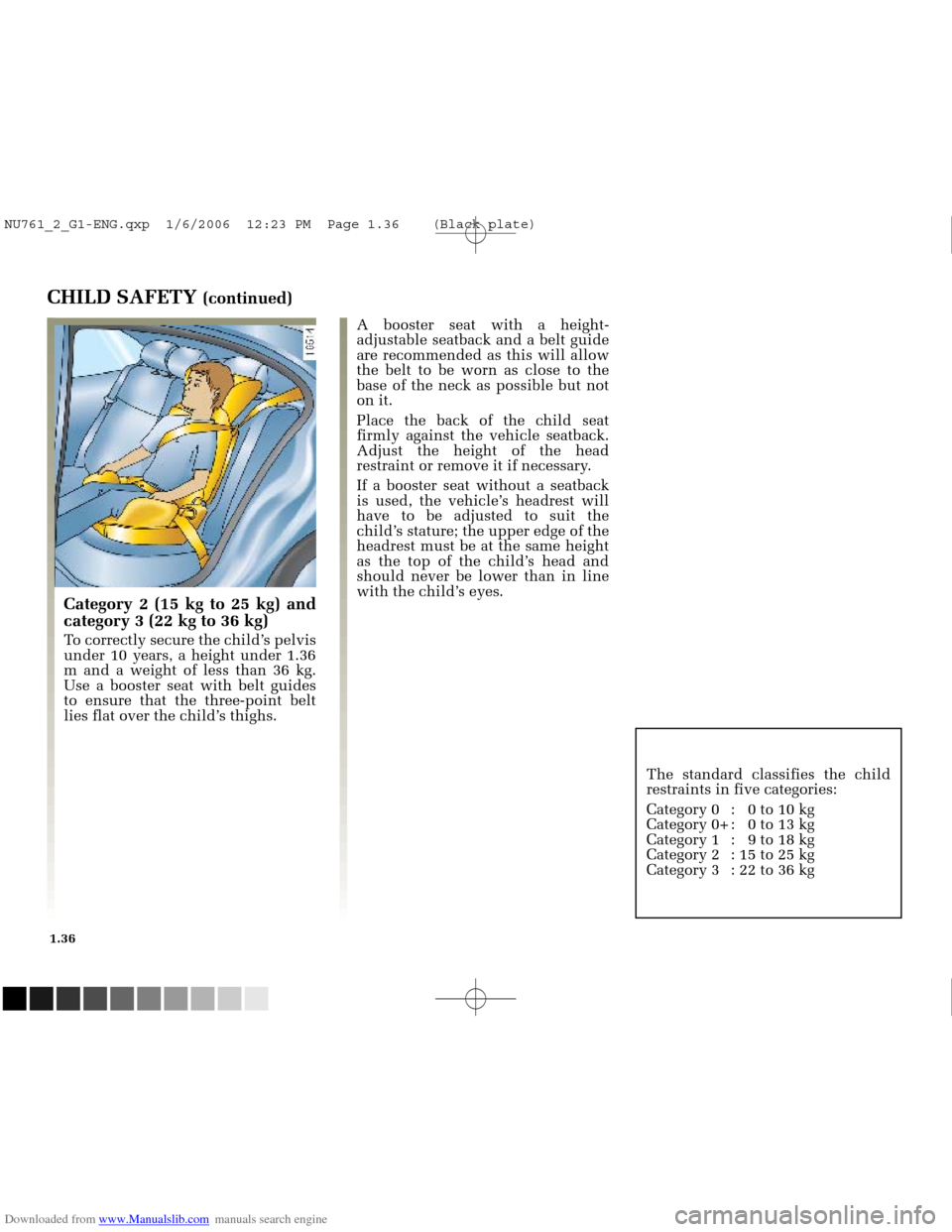
Downloaded from www.Manualslib.com manuals search engine
NU761_2_G1-FRA.qxd 10/11/05 15:53 Page 1.36
1.36
CHILD SAFETY (continued)
A booster seat with a height-
adjustable seatback and a belt guide
are recommended as this will allow
the belt to be worn as close to the
base of the neck as possible but not
on it.
Place the back of the child seat
firmly against the vehicle seatback.
Adjust the height of the head
restraint or remove it if necessary.
If a booster seat without a seatback
is used, the vehicle’s headrest will
have to be adjusted to suit the
child’s stature; the upper edge of the
headrest must be at the same height
as the top of the child’s head and
should never be lower than in line
with the child’s eyes.
Category 2 (15 kg to 25 kg) and
category 3 (22 kg to 36 kg)
To correctly secure the child’s pelvis
under 10 years, a height under 1.36
m and a weight of less than 36 kg.
Use a booster seat with belt guides
to ensure that the three-point belt
lies flat over the child’s thighs.The standard classifies the child
restraints in five categories:
Category 0 : 0 to 10 kg
Category 0+ : 0 to 13 kg
Category 1 : 9 to 18 kg
Category 2 : 15 to 25 kg
Category 3 : 22 to 36 kg
NU761_2_G1-ENG.qxp 1/6/2006 12:23 PM Page 1.36 (Black plate)
Page 173 of 250
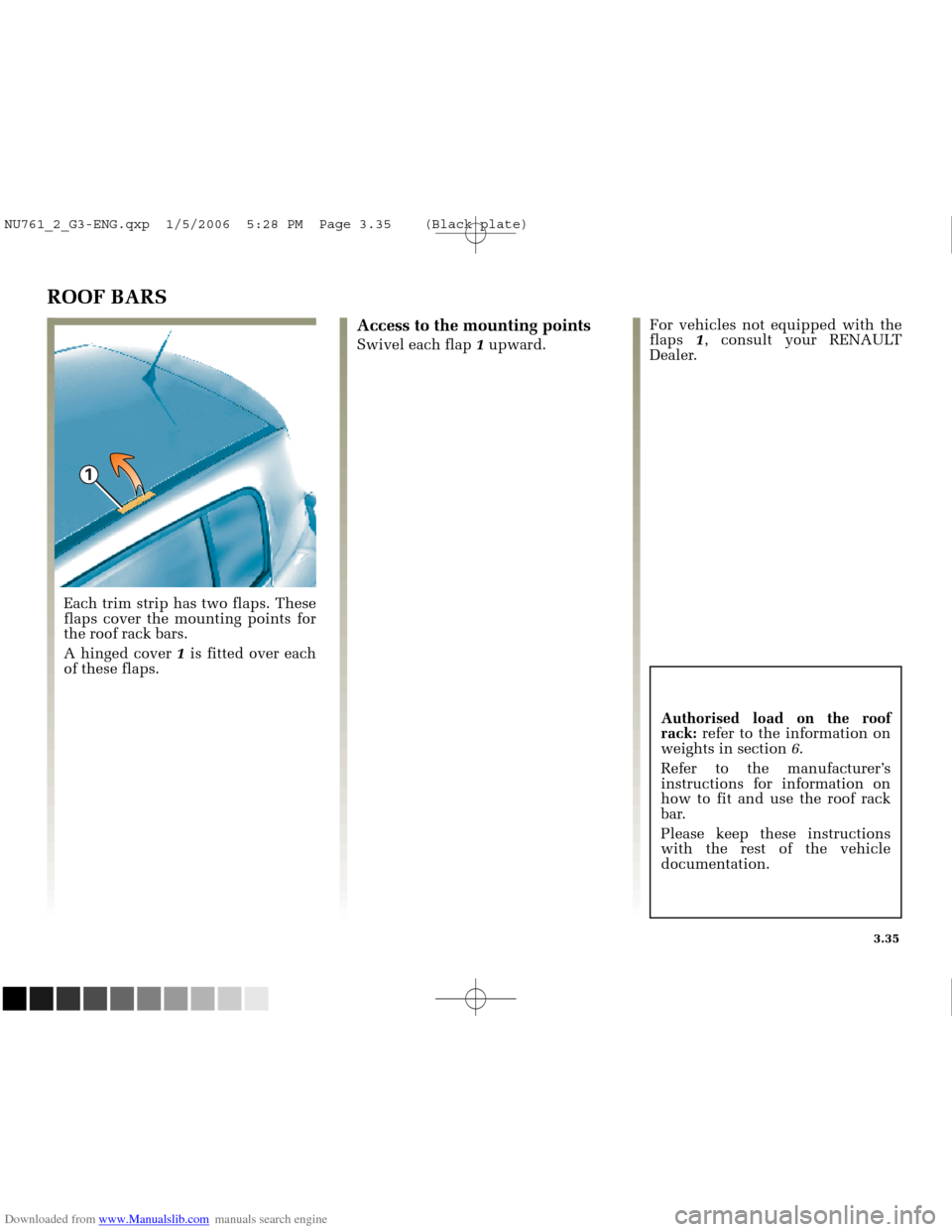
Downloaded from www.Manualslib.com manuals search engine
1
NU761_2_G3-FRA.qxd 4/11/05 10:52 Page 3.35
3.35
ROOF BARS
Each trim strip has two flaps. These
flaps cover the mounting points for
the roof rack bars.
A hinged cover 1is fitted over each
of these flaps. For vehicles not equipped with the
flaps
1, consult your RENAULT
Dealer.
Authorised load on the roof
rack: refer to the information on
weights in section 6.
Refer to the manufacturer’s
instructions for information on
how to fit and use the roof rack
bar.
Please keep these instructions
with the rest of the vehicle
documentation.
Access to the mounting points
Swivel each flap 1upward.
NU761_2_G3-ENG.qxp 1/5/2006 5:28 PM Page 3.35 (Black plate)
Page 177 of 250

Downloaded from www.Manualslib.com manuals search engine
3
4
5
NU761_2_G4-FRA.qxd 14/11/05 10:10 Page 4.03
4.03
BONNET (continued)
Lift the bonnet, release stay 4from
its holder 5and, for your own safety,
it is very important to fix it into
retainer 3in the bonnet.
Closing the bonnet
Before closing the bonnet, check to
make sure that nothing has been left
in the engine compartment.
To close the bonnet, replace stay 4in
its holder 5, hold the bonnet in the
middle and lower it 12 inches (30
cm) above the closed position, then
release it. It will latch automatically
under its own weight.
Check that the bonnet is
correctly locked.
NU761_2_G4-ENG.qxp 1/5/2006 5:29 PM Page 4.03 (Black plate)